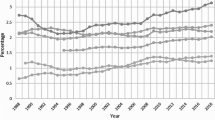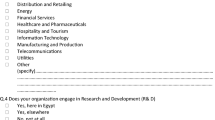Abstract
Recent data on European countries show that innovation leaders perform better than economies with low levels of innovation investment and institutions that do not favor knowledge and technology transfer activities. This result confirms that to achieve a high level of performance, countries need a balanced innovation system performing well across all dimensions. More interestingly, the two most important indicators that have been driving increases in performance include new doctoral graduates and international scientific co-publications, that is, two channels of knowledge transfer from universities to firms. This special issue of the Journal of Technology Transfer is dedicated to the discussion of models of university technology transfer, mostly from a European perspective.
Similar content being viewed by others
Notes
Carayannis and Grigoroudis (2014) present an up-to-date methodological framework for studying the dynamic linkage among innovation, productivity, and competitiveness and explore the implications for policy and practice.
Sweden, Denmark, Germany and Finland are Innovation leaders, while Latvia, Bulgaria and Romania are Modest innovators. The whole list of EU countries listed according to their degree of innovation can be found in European Commission 2015), pp. 11–14.
References
Acs, Z. J., Audretsch, D., & Feldman, M. P. (1994). R&D spillovers and recipient firm size. Review of Economics and Statistics, 76(2), 336–340.
Carayannis, E., & Grigoroudis, E. (2014). Linking innovation, productivity, and competitiveness: Implications for policy and practice. The Journal of Technology Transfer, 39(2), 199–218.
European Commission (2015). Innovation Union Scoreboard 2015. Brussels.
Jaffe, A. B., Trajtenberg, M., & Henderson, R. (1993). Geographic localization of knowledge spillovers as evidenced by patent citations. Quarterly Journal of Economics, 434, 578–598.
National Science Board (2014). Science and Engineering Indicators 2014. Arlington, VA: National Science Foundation (NSB 14-01).
Romer, P. M. (1990). Endogenous technological change. Journal of Political Economy, 98(5), S71–S102.
Solow, R. M. (1957). Technical change and the aggregate production function. Review of Economics and Statistics, 39, 312–320.
World Bank. (2013). Doing business 2014: Understanding regulations for small and medium-size enterprises. Washington, DC: World Bank Group. doi:10.1596/978-0-8213-9984-2.
Author information
Authors and Affiliations
Corresponding author
Rights and permissions
About this article
Cite this article
Calcagnini, G., Favaretto, I. Models of university technology transfer: analyses and policies. J Technol Transf 41, 655–660 (2016). https://doi.org/10.1007/s10961-015-9427-6
Published:
Issue Date:
DOI: https://doi.org/10.1007/s10961-015-9427-6
Keywords
- Knowledge and technology transfer
- Entrepreneurship
- Spinoffs
- Innovative start-ups
- Universities
- Science and technology parks




